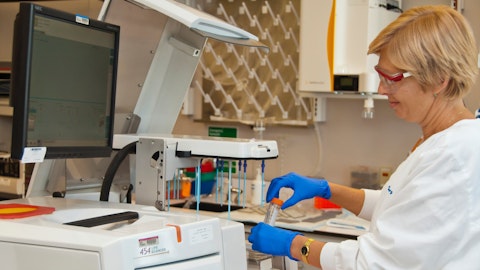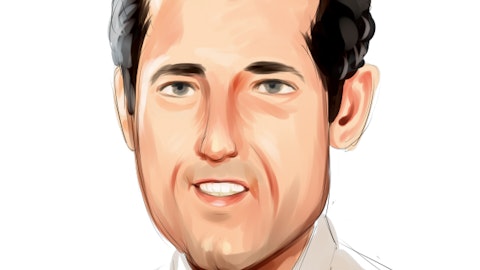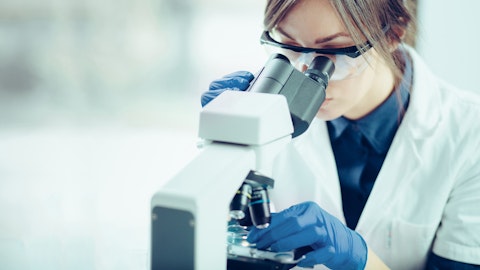Avantor, Inc. (NYSE:AVTR) Q4 2022 Earnings Call Transcript February 3, 2023
Operator: Good morning. My name is Emily, and I will be your conference operator today. At this time, I would like to welcome everyone to Avantor’s Fourth Quarter and Full Year 2022 Earnings Results Conference Call. I would now like to turn the call over to Christina Jones, Vice President of Investor Relations. Mrs. Jones, you may begin the conference.
Christina Jones: Good morning. Thank you for joining us. Our speakers today are Michael Stubblefield, President and Chief Executive Officer; and Tom Szlosek, Executive Vice President and Chief Financial Officer. The press release and a presentation accompanying this call are available on our Investor Relations website at ir.avantorsciences.com. A replay of this webcast will also be made available on our website after the call. Following our prepared remarks, we will open the line for questions. During this call, we will be making some forward-looking statements within the meaning of the federal securities laws, including statements regarding events or developments that we believe or anticipate may occur in the future. These forward-looking statements are subject to a number of risks and uncertainties, including those set forth in our SEC filings.
Actual results might differ materially from any forward-looking statement that we make today. These forward-looking statements speak only as of the date that they are made. We do not assume any obligation to update these forward-looking statements as a result of new information, future events or other developments. This call will include a discussion of non-GAAP measures. A reconciliation of these non-GAAP measures can be found in the supplemental disclosures package on our IR website. With that, I will now turn the call over to Michael.
Michael Stubblefield: Thank you, CJ, and good morning, everyone. I appreciate you joining us today. I’m starting on Slide 3. Fourth quarter results were in line with the guidance provided during our Q3 call. Our business grew 2.7% on a core organic basis, and we expanded adjusted EBITDA margin by over 60 basis points as customer demand and supply chains continue to normalize, as we transition from the COVID-19 pandemic, the temporary headwinds we have faced largely played out as expected. For the full year, we delivered core organic revenue growth of 6% at the high end of our long-term target of 4% to 6%, with growth across all geographies and product groups. We expanded adjusted EBITDA margin by 110 basis points, above our long-term target of 50 to 100 basis points and delivered $1.41 of adjusted EPS, outpacing our updated guidance of $1.38 to $1.40.
We continue to execute on our long-term strategy and growth drivers, including advancing a robust innovation pipeline, expanding our manufacturing and distribution capacity, enhancing our digital capabilities and leveraging the Avantor business system to drive operational rigor. More than 70% of our revenue is in Life Sciences. And over the course of the year, we introduced a number of new products to support our customers in growing biologics platforms, including monoclonal antibodies, cell and gene therapy and mRNA. We enhanced our proprietary consumable offering with the extension of our precision plastics portfolio under our J.T. Baker brand. We also introduced innovative kits and flow cells from Oxford Nanopore, which helped generate next-generation sequencing data at the highest consensus accuracy.
During the fourth quarter, we further augmented our global footprint and strengthened our ability to provide essential products and services to local biopharma customers as we opened our new CGMP distribution center in Dublin, Ireland, and produced our first commercial batches in our new CGMP manufacturing hub in Singapore. In addition, we continue to improve supply for bioproduction customers and reduce lead times for a broad range of products across our portfolio. We also completed a number of contract renewals with our largest customers, including our recently announced multiyear agreement with Catalent that significantly expands our relationship, making Avantor as their primary supplier across a broad range of lab supplies and services.
Continuous improvement is in our DNA. And in 2022, we completed more than 450 kaizen events focused on improving critical business processes, a 50% year-over-year increase. We also introduced enhancements to our organizational structure to strengthen commercial leadership, and we made significant progress in building out our strategy and corporate development team. We remain focused on execution, and our 14,500 associates are aligned with our enterprise priority of driving growth. We made significant progress in 2022 with our Science for Goodness platform, improving our ESG metrics from four major rating agencies. We are on pace to exceed our 2025 greenhouse gas emissions reduction targets and are accelerating our climate-related commitments in alignment with the latest science and look forward to sharing updates on our progress in this area in the coming months.
Looking ahead, our long-term algorithm remains fully intact and highlights the strength and resilience of our business. Our guidance for 2023, which Tom will cover shortly, reflects our confidence in the fundamental growth drivers for life sciences as well as the headwinds we face in the current operating environment. With that, let me turn it over to Tom to walk you through our financial results in more detail.
Thomas Szlosek: Thank you, Michael, and good morning, everyone. I’m starting on Slide 4. Starting from the top of the page, reported revenue was $1.795 billion for the quarter at the midpoint of guidance provided on our Q3 results call. Our core organic growth for the quarter was 2.7%, reflecting ongoing strength in our core business, partially offset by inventory destocking in liquid handling and single-use tubing that we flagged in our third quarter call, a weaker-than-expected year-end budget flush and approximately 170 basis points of headwind as a result of fewer selling days in the fourth quarter of 2022. For the full year, reported revenue was approximately $7.5 billion, and core organic growth was 6%, driven by over 20% core organic growth in bioproduction and double-digit growth in Advanced Technologies and Applied Materials, offset by approximately 70 basis points of headwind as a result of fewer selling days in 2022.
Adjusted gross profit for the quarter was 34.3% and 34.8% for the full year, an expansion of almost 90 basis points compared to 2021. This expansion was driven by the favorable impact of our 2021 acquisitions, double digit growth in sales of proprietary products and ongoing commercial excellence, partially offset by increased cost of materials and freight. Adjusted EBITDA was approximately $360 million in the quarter and $1.571 billion for the year, representing approximately 60 basis points and 110 basis points of margin expansion, respectively. The expansion was driven by our gross margin performance and our ongoing focus on productivity, while we continue to invest in growth. Adjusted earnings per share came in at $0.32 for the quarter and $1.41 for the year, driven by adjusted EBITDA performance, partially offset by higher interest expense and FX translation headwinds.
Adjusted net income grew double digits for the year on a constant currency basis. This double-digit earnings growth on 6% core organic growth demonstrates the powerful earnings conversion attributes of our business model. We generated free cash flow of $172 million in Q4 and $710 million for the full year, below our expectations of $800 million. In the fourth quarter, we made investments to support customer contract renewals and extensions, which lowered our free cash flow, but which will support our growth profile in the years to come. We also proactively built inventory levels as a countermeasure against global supply chain constraints and experienced higher accounts receivable balances throughout 2022. We have identified several opportunities to improve our working capital performance in 2023.
Our adjusted net leverage ended the year at 3.7 times adjusted EBITDA, down from 4.2 times at the start of the year, putting us within our stated target leverage of 2 to 4 times adjusted EBITDA. Overall, we delevered the balance sheet by 0.5 times in 2022 and remain focused on incremental deleveraging over the course of 2023. Slide 5 outlines the components of our revenue growth in the quarter and the year. Our Q4 core organic revenue growth of 2.7% was in line with our guidance of 2% to 4%. Customer destocking in select product categories like liquid handling consumables and single-use tubing played out as expected, and Europe performed better than we anticipated. COVID-related revenues represented a 4.8% headwind for the quarter versus our expectation of 4% as vaccine-related sales slowed further in the fourth quarter, resulting in a 2.1% organic revenue decline.
We had a modest M&A inorganic contribution of 0.7% in the fourth quarter associated with October sales for Masterflex, which laps its 1-year anniversary on November 1. Foreign exchange translation represented a 4.5% headwind driven primarily by the strength of the U.S. dollar versus the euro, resulting in a fourth quarter reported revenue decline of 5.9%. For the full year, the 6% core organic growth ended at the high end of our long-term growth algorithm, a testament of the health and resilience of our core business. COVID headwinds finished the year at 3.6%. We achieved $190 million of COVID-related sales in 2022. M&A contributed 3.6% and FX represented a 4.3% headwind, resulting in 1.7% reported growth for 2022. On to Slide 6. From a regional perspective, Americas, which represents approximately 60% of annual global sales was flat on a core organic basis in the fourth quarter, with strong growth in serum, process ingredients and excipients for bioprocessing and custom formulations for the semiconductor space, offset by destocking headwinds in liquid handling consumables and single-use tubing.
On a full year basis, Americas grew 6.1% on a core organic basis, driven by double-digit growth in bioprocessing, and Advanced Technologies and Applied Materials and strong contributions from Biomaterials. Europe, which represents approximately 35% of annual global sales achieved 6.3% core organic revenue growth in the fourth quarter and 5.5% for the year, above our expectations for the region, driven by strength in bioproduction and biomaterials. Bioproduction grew double digits in the fourth quarter on a core organic basis, driven by robust demand for our process ingredients, excipients and single-use solutions. Although industrial demand in Europe continues to be moderate as expected, our performance in this region reflects the value of our end market exposure and diversified application and customer mix and highlights the overall resilience of our business.

Tonhom1009/Shutterstock.com
EMEA, which represents approximately 5% of annual global sales grew 5.7% on a core organic basis in the fourth quarter and 7% for the full year, driven by sales of proprietary materials to advanced technologies and applied materials customers and bioproduction strength in process ingredients and excipients. Slide 7 shows our core organic revenue growth for the quarter by end market and product group. Biopharma representing almost 55% of our annual revenue, grew low single digits in the quarter, including high single-digit growth in bioproduction. Liquid handling and single-use inventory headwinds impacted fourth quarter growth, primarily in the Americas region. For the full year, biopharma grew high single digits, led by over 20% growth in bioproduction.
Health care, which represents approximately 10% of our annual revenue, declined mid-single digits on a core organic basis in the fourth quarter and grew low single digits for the full year, driven by strength in biomaterials, offset by inventory destocking in liquid handling consumables, which was particularly pronounced in the fourth quarter. Education and government, representing approximately 10% of our annual revenue, experienced a low single-digit core organic revenue decline in the fourth quarter and full year. Advanced technologies and applied materials, representing approximately 25% of our annual revenue, achieved high single-digit core organic revenue growth in the fourth quarter and double-digit growth for the full year, driven by growth in proprietary materials for semiconductor and electronic device applications, partially offset by a moderation in industrial demand in Europe.
By product group proprietary materials and consumables offerings grew high single digits in the quarter and double digits for the full year, driven by strong demand across our bioproduction, biomaterials and advanced technologies and applied materials platforms. Sales of third-party materials and consumables declined mid-single digits in the quarter and grew low single digits for the full year, impacted by a moderation in lab consumables demand relating to destocking. Services and Specialty procurement declined low single digits in Q4 and grew mid-single digits for the year, driven by strength in lab and production services. Equipment & Instrumentation sales grew low single digits in the quarter and the full year with growth across all three regions.
Moving to Slide 8, I’d like to provide an update on the contributions from our recent acquisitions. As a reminder, this slide reflects the 12 months revenue and margin for Masterflex, Ritter and RIM Bio in 2022. Full year results included $393 million of revenue and $136 million of adjusted EBITDA, resulting in a 35% adjusted EBITDA margin. Masterflex revenues were modestly below our estimates due to ongoing top line pressures relating to customer destocking in our tubing category and ongoing component shortages for peristaltic pumps. Despite the transitory headwinds, we are highly encouraged by the Masterflex leading market position, pipeline of exciting new product launches and robust demand from our bioproduction customers for our end-to-end fluid management solution.
Ritter revenue came in slightly above our revised expectations for the year, driven by a stabilization of the research and diagnostics platform as the COVID roll-off concluded in the second quarter. Europe industrial demand was slowed, albeit at a more moderate pace than anticipated. The team is working to convert our pipeline of commercial opportunities and introduce new products in our technology road map, including four significant product launches planned for the first half of this year. RIM Bio generated $10 million of revenue for the year, a supplier constraint pushed another $10 million of revenue from the fourth quarter to the first quarter of 2023. We are excited with the traction and momentum we have built with this business, including the successful transfer of 2D and 3D bag technology from RIM Bio to our global customers.
Looking at 2023, we expect Masterflex tubing headwinds to subside by midyear with a return to double-digit core organic growth in the back half of 2023. Ritter performance has stabilized, and we expect sequential improvement in Ritter revenue throughout 2023, as the effects of our commercial synergy program and NPI investments take hold. On the right hand of this page, we’ve provided an update on balance sheet leverage. We exited 2022 at 3.7 times leverage within our target range of 2 to 4 times leverage. We were able to mitigate the impact of rising rates on our 2022 interest expense through proactive interest rate management and debt pay down. Given the interest rate environment, we will continue to focus on deleveraging as we move into 2023, while also actively building our pipeline of M&A opportunities.
Turning to Slide 9. I’d like to walk you through our 2023 guidance. Beginning with revenue, we start with our long-term algorithm of 4% to 6% core organic growth, which is based on our differentiated position serving attractive end markets. We continue to see strong demand in Life Sciences and expect another year of double-digit core organic revenue growth in bioproduction. We are initiating 2023 core organic revenue growth guidance at 2.5% to 4.5%. We expect continued strength in bioproduction and a healthy overall pricing environment, moderated by the near-term inventory destocking in lab and single-use consumables, which we’ve discussed, as well as reduced demand from industrial applications globally, notably in our semiconductor end market.
Moving forward, we will not be categorizing revenue as COVID related, as it is expected to be immaterial. Consequently, the COVID headwind for 2023 is predetermined at about 2.5%. This results in organic revenue growth of 0% to 2%. We expect FX to be neutral for the full year at our current planning rates, leading to a reported growth of 0% to 2%. On adjusted EBITDA, we expect margin to range from 25 basis points of contraction to 25 basis points of expansion with commercial excellence, growth in our proprietary offerings and productivity tempered by the macro inventory headwinds, the dilutive impact of the COVID revenue roll-off and ongoing inflationary pressures. We have a track record of delivering strong margin expansion, and we are working diligently to find opportunities to offset margin headwinds, including leveraging our Avantor business system to execute on a robust funnel of productivity initiatives.
For earnings, we are initiating our 2023 guidance at $1.35 to $1.45 adjusted earnings per share, which reflects the range of our revenue and margin expectations, as well as interest expense of $270 million to $295 million and a 21.5% tax rate. Our interest expense estimate reflects the impact of current forward yield curves on the roughly 30% of our unhedged variable rate debt. The rate increases are expected to have an unfavorable year-over-year impact on interest expense of about $65 million that will be largely offset by the impact of deleveraging. We expect to generate approximately $700 million to $800 million of free cash flow, which includes a modest improvement in working capital as our supply chain continues to normalize. Regarding pacing, the more pronounced 2023 first half COVID headwinds and inventory destocking result in more tempered expectations for the first half of 2023 compared with the second half.
We expect first quarter core organic revenue declines of 1.5% to 3.5% and COVID headwinds of 4.5%, leading to organic revenue declines of 6% to 8%. This reflects more difficult comparables in the first quarter as well as our assumptions around industrial demand globally, including semiconductors. We also expect a roughly 2.5% headwind from FX, leading to reported revenue of 17.50 to 17.85 With that, I will now hand the call to Michael.
Michael Stubblefield: Thanks, Tom. As we conclude, I want to emphasize our conviction in our long-term financial algorithm. We view the current headwinds and supply chain normalization as short-term dynamics that will subside in the second half of the year, as supported by internal analysis, ongoing customer interactions and industry trends. We are confident in our plan for 2023 and are well positioned to execute on our growth strategy. I am encouraged by the strong fundamentals in our end markets, the deep relationships we have with customers and the positive returns we are generating from our investments in innovation and capacity expansions. Our strong free cash flow enables rapid deleveraging and capital allocation flexibility as we continue to actively build our M&A pipeline. Thank you for your interest in Avantor and for your continued support. I will now turn it over to the operator to begin the question-and-answer portion of our call.
See also 10 Recent Spinoff Companies Hedge Funds Are Buying and Dividend Kings and Artistocrats List.
Q&A Session
Follow Avantor Inc. (NYSE:AVTR)
Follow Avantor Inc. (NYSE:AVTR)
Q – Patrick Donnelly: Hey, guys. Good morning. Thanks for taking the questions. Michael, maybe just on a couple of those variables as we enter ’23 here. It seems like European – industrial demand, you guys were pretty cautious last quarter going out some risks in the macro. It seems like you’re feeling a little bit better about that. And then the second one, obviously, some of that excess inventory in the system on the lab business, particularly in the liquid handling. Can you maybe just talk about those two? What they look like in terms of variability in the guidance? And then the visibility, particularly on that excess inventory, what you’re hearing from customers visibility into that normalizing? And when we should expect that to kind of get back to kind of growth and a little bit more normal? Thank you.
Michael Stubblefield: Thanks for the question, Patrick. And good morning, everyone. Yeah, I think that’s a great place to start. When you point out the dynamics that we saw in the fourth quarter on Europe certainly played out a bit better than we expected, and we’re certainly pleased with more than 6% core organic revenue growth there in the quarter. It really continues a strong year that we had there in the region. Entering the quarter, I think we were trying to reflect just some of the uncertainty associated with the energy situation in Europe. Certainly, the conflict in Ukraine, as well as just overall recessionary concerns and it certainly played out a bit better than we had anticipated. And as we look ahead into the year, I think we’re encouraged by the trends that we see there, although we remain a little bit cautious.
From a destocking perspective, I think the quarter played out as we had anticipated, both in liquid handling consumables, as well as in the single-use consumables within our bioprocessing offering and transitioning into 2023, I think the picture for us remains largely unchanged. As we engage with our customers, as we triangulate a number of reports and analytics that we have, I think our view here is that it’s probably something that will be with us throughout the first half of the year, which will lead to a dynamic here that Tom referenced with the second half of the year being stronger than the first half. So we’ll expect ongoing destocking here in the first quarter should start to improve a bit as we move through the second quarter, and we would expect that to hopefully be behind us as we get into the second half of the year.
Operator: Our next question comes from Rachel Vatnsdal with JPMorgan. Please go ahead, Rachel.
Rachel Vatnsdal: Great. Thanks, guys. So my question is just around margins. You guys exited 4Q at roughly 19.5% EBITDA margin. You’re guiding to down 25 – to 25 basis points for the year. So can you just talk about some of the puts and takes, very similar to Patrick’s question, given some of these headwinds in the start of the year, how should we think about that EBITDA margin expansion or contraction on a quarterly basis? And then is that mainly driven by price or volume? Or kind of how should we see that rolling through the P&L? Thank you.
Michael Stubblefield: Thanks for the question, Rachel. I think I’d start by just reiterating our confidence in our ability to continue to expand margins. And I would point to the fourth quarter as a good proof point of that. The environment we saw in the fourth quarter is probably pretty similar to what we’re anticipating as we move into the new year here, and we’re coming off a quarter here where we did expand 60 basis points. So certainly, a strong track record of being able to do that. When you look at our margin expansion algorithm, there’s probably two or three variables that we really focus on, certainly starting with managing price versus COGS. A big part of that process plays out in the fourth quarter and early days of the first quarter.
We’re pretty well through that. And I think we’re pretty confident that although pricing is going to be above our long-term algorithm and similar to what we delivered last year, we do think it’s going to be sufficient to contribute at a level that we would historically see. You then get into things like mix, and we’ve talked openly about the roll-off of the COVID headwinds that are pretty margin rich. We’re working against us, as we move through the year. That’s going to be more pronounced in the first and second quarter than it would be in the second half of the year. And then the last variable I mentioned is just around the productivity aspects of our program here. We’ve got a pretty full pipeline of opportunities that we’re driving to help mitigate the impacts of inflation.
So I would say largely the algorithm is intact. We’ll – we tried to reflect some of the headwinds associated with the mix, as well as just the volume impact and as destocking and COVID come down and the impact that, that has on absorption. But I think we’re cautiously optimistic here out of the gates as we look ahead to margins and look to build on our strong track record.
Operator: Our next question comes from Luke Sergott with Barclays. Please go ahead, Luke.
Luke Sergott: Great. Good morning, everyone. So two for me. So just quickly on Masterflex came in a little light versus your guide for the year. Any kind of commentary there, what you guys are seeing in the fourth quarter? And any signs that this is troughed and starting to get better from a destocking perspective and the various headwinds there? And then secondly, can you talk about – I mean, you guys have talked about the investments you made in the customers. And you just came out with the master service agreement with – or the service agreement with Catalent. Can you give us any other color that you’re around the future or current deals that you guys are working on that kind of underlie the improving outlook here?





